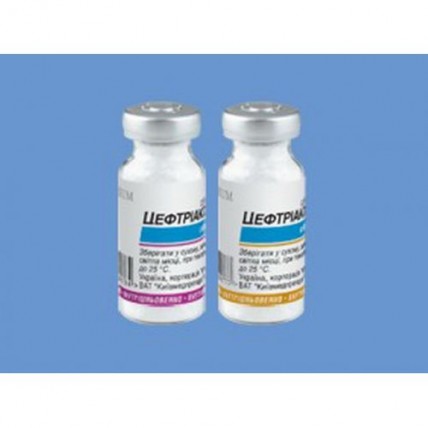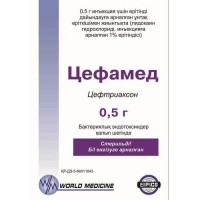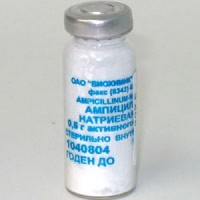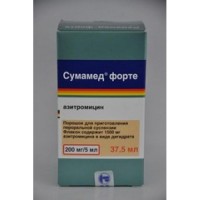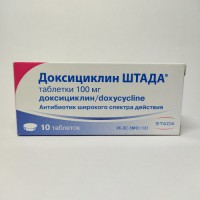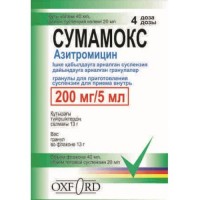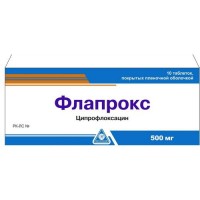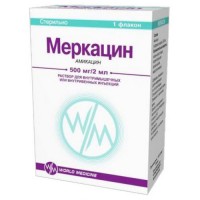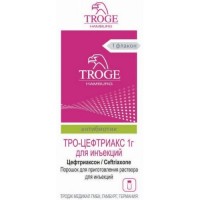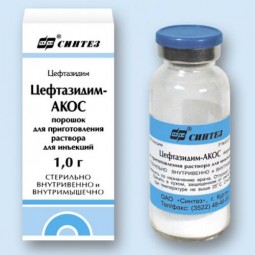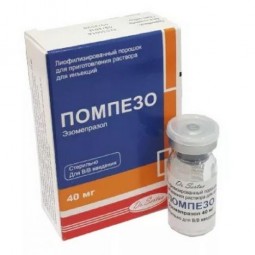Ceftriaxone-ILC 1's 1g powder for solution for injection
- $3.60
Out Of Stock
The instruction for medical use
of TsEFTRIAKSON-KMP medicine
the Trade name
Tseftriakson-KMP
Mezhdunarodnoye the unlicensed
name Tseftriakson Lekarstvennaya a form
Powder for preparation of solution for injections of 0.5 g and 1.0 g
Structure
One bottle contains
active agent - tseftriakson sodium sterile vperescht on tseftriakson - 0.5 g or 1.0 g.
Description
Crystal powder of color, white or white with slegkazheltovaty shade. It is poorly hygroscopic.
Pharmacotherapeutic group
Antimicrobial means for system use. Tsefalosporinytrety generation.
The code of automatic telephone exchange J01D D04
the Pharmacological
Pharmacokinetics of a Tseftriakson properties has nonlinear character. The Vseosnovny pharmacokinetic parameters which are based on the general of the koncentratsiyakhpreparat except for elimination half-life, depend on a dose.
Absorption. The maximum concentration in blood plasma of postsingle intramuscular introduction of 1 gpreparat makes 81 mg/l and a dostigayetsyaz 2-3 hours after introduction. The area under a concentration curve in plasma to a kroviposla of intravenous administration equals that after intramuscular introduction. It means that the bioavailability of a tseftriakson after intramuscular vvedeniyasostavlyat 100%.
Distribution. Volume of distribution of a tseftriakson sostavlyaet7-12 l. After introduction in a dose 1-2 gtseftriakson well gets into fabrics and liquids of an organism. During more chem24 hours of its concentration much more exceed the minimum podavlyayushchiyekoncentration for the majority of causative agents of infections more than in 60 fabrics and liquids (including lungs, heart, biliary tract, a liver, tonsils, a srednemukha and a mucous membrane of a nose, bones and also spinal, pleural isinovialny liquids, in secretion of a prostate).
After intravenous administration tseftriakson quickly gets vspinnomozgovy liquid where bactericidal concentration of otnositelnochuvstvitelny microorganisms remain within 24 hours.
Tseftriakson reversibly contacts albumine, prichemstepen binding decreases with concentration growth, for example less than 100 mg/l decrease to 85% about 95%pr of concentration in blood plasma at concentration 300mg/l. Thanks to lower concentration of albumine in an intercellular lymph of a dolyasvobodny tseftriakson in it higher, than in blood plasma.
Penetration into separate fabrics. Tseftriakson gets a cherezvospalenny meninx at children, including newborns. Through 24 chasaposl of intravenous administration of a tseftriakson in a dose of 50-100 mg/kg of body weight (to newborns and babies respectively) concentration of a tseftriakson of vspinnomozgovy liquid exceed 1.4 mg/l. The maximum concentration of vspinnomozgovy liquid is reached approximately in 4 hours of postintravenous administration and averages 18 mg/l. At a bakterialnommeningita the average concentration of a tseftriakson in cerebrospinal zhidkostisostavlyat 17% of concentration in blood plasma, in aseptic meningitis - 4%. At adult patients with meningitis after introduction of a dose of 50 mg/kg of body weight cherez2-24 hour the concentration of a tseftriakson in cerebrospinal liquid many times exceeding the minimum inhibiting concentration for samykhrasprostranenny causative agents of meningitis are reached.
Tseftriakson gets through a platsentny barrier and in malykhkoncentration – into breast milk.
Metabolism. Tseftriakson does not give in to system metabolism, and turns into inactive metabolites under the influence of indestinal flora.
Removal. The general plasma clearance of a tseftriakson equals 10-22 ml/min. The renal clearance equals 5-12 ml/min. of 50-60% of a tseftriakson also 40-50% are removed the extra changed look by kidneys - in not changed view with bile. The period of a poluvyvedeniyatseftriakson at adults is about 8 hours.
Pharmacokinetics
in special clinical cases. Unovorozhdennykh kidneys is brought by about 70% of a dose. At children the first 8 dneyzhizn and also at patients are more senior than 75 years elimination half-life on average in a 2-3raz more, than at adults of young age.
At patients with renal or hepatic the nedostatochnostyyupharmakokinetika of a tseftriakson changes in an insignificant measure, lishneznachitelny increase in elimination half-life is noted. If it is broken only funktsiyapochek, removal with bile increases if function of a liver is broken, removal by kidneys increases.
A pharmacodynamics
Tseftriakson-KMP - a tsefalosporinovy antibiotic of the III generation sprolongirovanny action.
Bactericidal activity Tseftriaksona-KMP obuslovlenaugneteniye of synthesis of cellular membranes. Tseftriakson is active in vitro of rather bolshinstvagramotritsatelny and gram-positive microorganisms. It Tseftriakson-KMPharakterizutsya by very big resistance to the majority of b-laktamaz (as penicillinases, and tsefalosporinaz) gram-positive and gramotritsatelnykhbakteriya. Tseftriakson-KMP is active rather following microorganisms of invitro and in clinical infections (see the section Indications):
Gram-positive aerobes. Staphylococcus aureus (metitsillinchuvstvitelny), koagulazootritsatelny staphylococcus, Streptococcuspyogenes (β-hemolytic, groups A), Streptococcus agalactiae (β-hemolytic, groups B), β-hemolytic streptococci (groups And, C), Streptococcusviridans, Streptococcus pneumoniae.
Note. Resistant to Staphylococcus spp Methicillinum. rezistentna to cephalosporins, including to a tseftriakson. Also Enterococcusfaecalis, Enterococcus faecium and Listeria monocytogenes an obnaruzhivayutustoychivost to a tseftriakson.
Gram-negative aerobes. Acinetobacter lwoffi, Acinetobacter anitratus (mainly A. baumanii) *, Aeromonas hydrophila, Alcaligenes faecalis, Alcaligenes odorans, alkagenopodobny bacteria, Borreliaburgdorferi, Capnocytophaga spp., Citrobacter diversus (including C.amalonaticus), Citrobacter freundii *, Escherichia coli, Enterobacteraerogenes *, Enterobacter cloacae *, Enterobacter spp. (others) *, Haemophilusducreyi, Haemophilus influenzae, Haemophilus parainfluenzae, Hafnia alvei, Klebsiella oxytoca, Klebsiella pneumoniae **, Moraxella catarrhalis (Branhamella catarrhalis raneenazyvatsya), Moraxella osloensis, Moraxella spp. (others), Morganella morganii, Neisseria gonorrhea, Neisseria meningitidis, Pasteurellamultocida, Plesiomonas shigelloides, Proteus mirabilis, Proteus penneri *, Proteus vulgaris *, Pseudomonas fluorescens *, Pseudomonas spp. (others) *, Providentiarettgeri *, Providentia spp. (others), Salmonella typhi, Salmonella spp. (netifoidny), Serratia marcescens *, Serratia spp. (others) *, Shigella spp., Vibrio spp., Yersinia enterocolitica, Yersinia spp. (others).
* Some isolates of these types are resistant to tseftriaksonuglavny in the way owing to education β-лактамаз, coded by chromosomes.
** Some isolates of these types are steady to tseftriaksonuvsledstvy formation of a row plazmidooposredovanny β-лактамаз.
Note. Many of strains of the vysheupomyanutykhmikroorganizm having multiple resistance to such antibiotics, kakaminopenitsillina and ureidopenicillin, cephalosporins of the first and a vtorogopokoleniya, aminoglycosides are sensitive to a tseftriakson. Treponemapallidum is sensitive to a tseftriakson of in vitro and in animal experiments. Clinical trials show that tseftriakson it is effective for lecheniyapervichny and secondary syphilis, except for the clinical strains of P.Aeruginosa resistant to a tseftriakson.
Anaerobe bacterias. Bacteroides spp. (sensitive to bile) *, Clostridiumspp. (except C. difficile), Fusobacterium nucleatum, Fusobacterium spp. (others), Gaffkia anaerobica (Peptococcus were called earlier), Peptostreptococcusspp.
* Some isolates of these types are steady to tseftriaksonuvsledstvy formations β-лактамаз.
Note. Much of strains of Bacteroides spp. producing b-lactamazu (in particular B. fragilis), are resistant to a tseftriakson. Clostridium difficile is steady.
The sensitivity to Tseftriaksonu-KMP can be determined metodomdisk or method of serial delution on an agar or broth, an ispolzuyastandartny technique, similar by that which recommends National komitetklinichesky laboratory standards (NKKLS). For Tseftriaksona-KMP NKKLSustanovil such criteria for evaluation of results of tests:
For determination of sensitivity of microorganisms to sleduyetispolzovat disks with tseftriaksony as tseftriakson it is active the otnositelnootdelny strains steady at use of the disks intended dlyavsy group of cephalosporins. Instead of the NKKLS standards, for definition of chuvstvitelnostimikroorganizm it is possible to use also others well standartizirovannyenormativa, for example DIN and ICS allowing to estimate adequately urovenchuvstvitelnost.
Indications
Treatment of the infections caused by microorganisms, sensitive to drug, including:
- respiratory infections (especially pneumonia)
- infections of ENT organs
- infections of kidneys and urinary tract
- infections of genitals (including gonorrhea)
- infections of skin and soft tissues
- infections of abdominal organs: peritonitis, infektsiizhelchevyvodyashchy ways and a digestive tract
- sepsis
- infections of bones, joints
- wound fevers
- infections at patients with the weakened host defense
- meningitis
- disseminate borreliosis of Lyme: early and late stadiizabolevaniye.
Preoperative prevention of infections at hirurgicheskikhvmeshatelstvo:
- on bodies of a digestive tract
- biliary tract
- urinary tract
- in vremyaginekologichesky procedures, but only in case of potential or izvestnoykontamination.
When assigning Tseftriaksona-KMP it is necessary priderzhivatsyaofitsialny recommendations about antibiotic treatment and, in particular, recommendations for an antibiotikorezistentnost poprofilaktika.
The route of administration and doses
Tseftriakson-KMP apply intramusculary and intravenously. Perednachal therapy with use Tseftriaksona-KMP needs to exclude availability of the upatsiyent of intolerance of drug, having taken skin samples.
Adults and children are more senior than 12 years: usually appoint 1-2 g Tseftriaksona-KMP of 1 times of a vsutka (each 24 hours). In heavy infections or infections, vozbuditelikotory have only moderate sensitivity to a tseftriakson, daily dozumozhno to increase up to 4 g.
Children.
Newborns (up to 2 weeks): 20-50 mg/kg of body weight of 1 times of a vsutka. The daily dose should not exceed 50 mg/kg of body weight. At a drug opredeleniidoza for the full-term and premature children there are no distinctions.
Newborns and children from 15 days to 12 years: 20-80 mg/kg of a massytel of 1 times a day.
To children with body weight over 50 kg appoint doses dlyavzrosly. Intravenous doses of 50 mg/kg or should be entered by infusion above within at least 30 minutes.
Patients of advanced age.
Dose adjustment is not necessary to patients of advanced age.
Duration of treatment depends on the course of the disease. Kakprinyato at therapy by antibiotics, the patient it is necessary to continue prinimattseftriakson within at least 48-72 hours after it temperaturanormalizutsya and analyses show lack of activators.
Combination therapy. Rather mnogikhgramotritsatelny bacteria there is synergism between tseftriaksony iaminoglikozidam. In spite of the fact that such the kombinatsiyena can always provide the increased efficiency, it should be meant in the presence of the heavy, life-threatening infections caused by Pseudomonas aeruginosa. Because of a fizicheskoynesovmestimost of a tseftriakson and aminoglycosides they should be entered separately vrekomendovanny doses.
Dosing in special cases.
In bacterial meningitis at babies and children in vozrasteot 15 days up to 12 years treatment begin with a dose 100 mg/kg (but no more than 4 g) 1 time a day. As the tolkovozbuditel will be identified, and his sensitivity is defined, dozumozhno respectively to lower. The best results were achieved at a treatment takoydlitelnost:
Neisseria meningitidis Haemophilus influenzae Streptococcus pneumoniae
is 4
days 6 days 7 days old
Borellioz Laima: to adults and children - 50 mg/kg (a naivysshayasutochny dose - 2 g) 1 time a day within 14 days.
For treatment of the gonorrhea (caused by the strains producing ineprodutsiruyushchy penicillinase) it is recommended to appoint single dozu250 mg intramusculary.
For prevention of postoperative infections in it hirurgiirekomendutsya depending on degree of danger of infection to enter single dozu1-2 a gtseftriakson in 30-90 minutes prior to operation. At a large ipryamy intestine surgeries well proved simultaneous (but separate) vvedeniyetseftriaksona-KMP and one of 5 nitroimidazoles, for example an ornidazol.
Renal and liver failure. Patients from a narusheniyamifunktion of kidneys do not have need to reduce a dose in case function pecheniostatsya by normal. Only in case of a renal failure in a preterminalnoystadiya (clearance of creatinine less than 10 ml/min.) the daily dose should not exceed 2 g. Patients from a narusheniyamifunktion of a liver do not have need to reduce a dose in case function pochekostatsya by normal. At simultaneous heavy renal and pechenochnoynedostatochnost the vplazma of blood should define regularly concentration Tseftriaksona-KMP and to carry out drug dose adjustment in case of need. Dlyabolnykh, being on a hemodialysis, there is no requirement in additional the vvedeniipreparat after dialysis. It is necessary to control, however, koncentratsiyutseftriaksona-KMP in blood serum regarding possible dose adjustment, to a poskolku of these patients clearance rate can decrease. Daily dozatseftriaksona-KMP for the patients who are on a hemodialysis should not exceed 2 g.
Preparation of solutions.
It is necessary to prepare solutions just before an ikhprimeneniye. Freshly cooked solutions keep physical and a khimicheskuyustabilnost within 6 hours at the room temperature (or within 24 hours at a temperature of 2-8 °C). Depending on concentration and a dlitelnostikhraneniye color of solutions can vary from pale yellow to amber. Etosvoystvo of active agent does not affect efficiency or the perenosimostpreparat.
For an intramuscular injection of 1 g dissolve in 3.5 ml of 1%rastvor of lidocaine, inject deeply in a gluteus. To Recomenduyetsyavvodit no more than 1 gv one buttock.
The solution containing lidocaine cannot be entered intravenously.
For an intravenous injection dissolve 1 g Tseftriaksona-KMP in the 10th mlsterilny water for injections, enter intravenously slowly (2-4 minutes).
Intravenous injection has to last not less than 30 minutes. Dlyaprigotovleniya of solution for injection rastvoryayut2 Mr. Tseftriaksona-KMP in 40 mlodny of the following infusion solutions free from calcium ions: 0.9%khlorid sodium, 0.45% sodium chloride + 2, 5% glucose, 5% glucose, 10%glyukoz, the dextran in solution of glucose of 5%, 6-10% hydroksietilirovannyykrakhmat 6%, water for injections. Considering the possible incompatibility, solutions containing tseftriakson it is impossible to mix with the solutions containing drugiyeantibiotik both at preparation, and at introduction.
It is impossible to use kaltsiysoderzhashchy solvents, takiyekak Ringera solution or Gartman's solution, for dissolution Tseftriaksona-KMP voflakona or for cultivation of the restored solution for a vnutrivennogovvedeniye in connection with the probability of formation of precipitated calcium superphosphates of calcic salts of a tseftriakson. Formation of precipitated calcium superphosphates of calcic salts of a tseftriakson also can proiskhoditpr mixing Tseftriaksona-KMP with kaltsiysoderzhashchy solutions in an odnoyinfuzionny system for intravenous administration. Tseftriakson-KMP nelzyaodnovremenno to enter intravenously with kaltsiysoderzhashchy solutions, including sdlitelny kaltsiysoderzhashchy infusions, for example parenteral nutrition (see. Interaction with other medicines and others of vidyvzaimodeystviye).
Side effects
Usually tseftriakson it is transferred well. At its primeneniivozmozhna such by-effects regressing spontaneously or after the otmenypreparat:
- diarrhea, nausea, vomiting, stomatitis, a glossitis
- an eosinophilia, a leukopenia, a granulocytopenia, hemolytic anemia, thrombocytopenia, increase in a prothrombin time
- mycosis of a genital tract, consecutive fungal infections and infections, vyzvannyerezistentny microorganisms
Seldom
- a headache and dizziness, fever, a fever and also anaphylactic ilianafilaktoidny reactions
- the rash, allergic dermatitis, an itching, a small tortoiseshell, hypostases, a dieback
- pancreatitis
- an oliguria, a hamaturia, a glucosuria, increase in an urovnyakreatinin in blood serum
is Very rare
- a pseudomembranous coloenteritis
- an agranulocytosis (& lt, 500/mm3), mainly postuses of the general dose 20 git more. During long-term treatment follows regularly a blood controlirovatkartin,
- an exudative multiformny erythema (Sindromstivensa-Johnson), a toxic epidermal necrolysis (Lyell's disease)
- coagulation disorders
- precipitated calcium superphosphates of calcic salt of a tseftriakson in a gall bladder from sootvetstvuyushcheysimptomatiky at children, a reversible cholelithiasis at children (the specified phenomena redkonablyudatsya at children), widespread - increase in urovnyapechenochny enzymes in blood serum (nuclear heating plant, ALT, alkaline phosphatase),
- formation of concrements in kidneys, mainly at children of 3 years, poluchavshikhbolshy daily doses of drug (≥ 80 mg/kg for day) or cumulative a dozysvysha of 10 g and also in the presence of accessory factors of risk (limited upotrebleniyezhidkost, a bed rest). Formation of concrements in kidneys can protekatbessimptomno or clinically be shown, can entail a pochechnuyunedostatochnost which passes after the treatment termination tseftriaksony,
In isolated cases inflammatory reaktsiistenka of a vein are observed. They can be avoided, applying a slow injection (2-4 minutes). The intramuscular injection without use of lidocaine is painful
Contraindications
- hypersensitivity to cephalosporins (in the presence at the patient of a povyshennoychuvstvitelnost to penicillin it is necessary to consider a possibility of perekrestnoyallergichesky reaction to a tseftriakson), to lidocaine
- age of premature children ≤ 41 weeks, considering the term of pre-natal development (gestational age + age after the birth)
- the neonatality period up to 28 days at: hyperbilirubinemias (in communication by a sosposobnost of a tseftriakson to force out bilirubin from communication with syvorotkikrova albumine that can result in risk of developing the encephalopathy caused by bilirubin), need (or the expected need) treatments by vnutrivennymikaltsiysoderzhashchy solutions, including intravenous kaltsiysoderzhashchiyevlivaniye, for example parenteral nutrition, in connection with risk of obrazovaniyapretsipitat of calcic salts of a tseftriakson.
Medicinal interactions
cannot be applied Tseftriakson-KMP skaltsiysoderzhashchy solutions At all (Ringera solution and so forth). It is not necessary to appoint Kaltsiysoderzhashchy solutions within 48 hours of the postlast introduction Tseftriaksona-KMP.
Newborn and premature children have sluchaiobrazovaniye of precipitated calcium superphosphates in the lungs and kidneys which entailed lethal consequences priodnovremenny introduction Tseftriaksona-KMP and calcium drugs.
At simultaneous use of high doses Tseftriaksona-KMP of itaky strong diuretics as furosemide, renal failures were not observed.
There are no data that Tseftriakson-KMP raises a pochechnuyutoksichnost of aminoglycosides. After alcohol intake right after priyematseftriaksona-KMP the effects similar to effect of Disulfiramum (Teturamum) were not observed.
Tseftriakson-KMP does not contain N-methylthiotetracindery group which could cause intolerance of ethanol and also bleedings, chtosvoystvenno to some other cephalosporins.
Probenetsid does not influence removal Tseftriaksona-KMP.
There is an antagonism between chloramphenicol and Tseftriaksonom-KMP.
It is impossible to use kaltsiysoderzhashchy solvents, takiyekak Ringera solution or Gartman's solution for dissolution Tseftriaksona-KMP voflakona or for cultivation of the restored solution for a vnutrivennogovvedeniye in connection with the probability of formation of precipitated calcium superphosphates calcic soleytseftriaksona-KMP. Formation of precipitated calcium superphosphates of calcic salts of a tseftriakson takzhemozht to happen when mixing Tseftriaksona-KMP to kaltsiysoderzhashchimirastvor in one infusional system for intravenous administration. Tseftriaksonnelzya to enter intravenously along with kaltsiysoderzhashchy solutions, in the tomchisl with long kaltsiysoderzhashchy infusions, for example a parenteralnoyepitaniye (see.
The route of administration and doses
At babies is raised risk of obrazovaniyapretsipitat of calcic salts of a tseftriakson.
Tseftriakson-KMP is incompatible with amzakriny, Vancomycinum, flukonazoly and aminoglycosides.
Bacteriostatic means can influence a bakteritsidnoyedeystviye of cephalosporins.
Tseftriakson-KMP can reduce efficiency of gormonalnykhperoralny contraceptives. In this regard it is recommended primenyatdopolnitelny (non-hormonal) methods of contraception during treatment and within 1 month after treatment.
There are no messages about interaction between Tseftriaksonom-KMP ikaltsiysoderzhashchy products for oral administration and interaction mezhdutseftriaksonom-KMP at an intramuscular injection and kaltsiysoderzhashchy products (intravenously or orally).
Special instructions
As well as at use of other cephalosporins, at primeneniitseftriaksona-KMP are possible anaphylactic reactions with a lethal outcome, there is no dazheesla in the detailed anamnesis the corresponding instructions. At vozniknoveniiallergichesky reactions tseftriakson it is necessary to cancel at once and naznachitsootvetstvuyushchy treatment.
Tseftriakson-KMP can increase a prothrombin time. In this regard at suspicion on deficiency of vitamin K opredelyatprotrombinovy time is necessary.
Against the background of use practically all antibakterialnykhpreparat including Tseftriaksona-KMP, development of the diarrhea associated with Clostridium difficile from light severity to colitis by a sletalny outcome is possible. Antibacterial drugs change normal florutolsty intestines that leads to the overgrowth of Clostridium difficile.Clostridium difficile produces toxins A and B, the promoting razvitiyudiare, associated with Clostridium difficile. Clostridium difficile strains which are excessively producing toxins cause the increased incidence an iletalnost as these infections can be resistant to antimikrobnymsredstvo and demand colectomy. The diarrhea associated with Clostridium difficile needs to be excluded at all patients during use of antibiotics. It is necessary to collect the detailed medical anamnesis as diarrhea, assotsiiruyemayas Clostridium difficile, can arise within two months after an okonchaniyaprimeneniye of antibacterial agents. At suspicion or confirmation of the diarrhea associated with Clostridium difficile it is necessary to cancel the antibiotic treatment which is not influencing Clostridium difficile. During a long primeneniyatseftriaksona-KMP, difficulties in monitoring insensitive to a kpreparat of microorganisms are possible. In this regard careful supervision of a zapatsiyentama is necessary. At development of superinfection it is necessary to take the appropriate measures.
After use Tseftriaksona-KMP in doses, prevyshayushchikhstandartny recommended, at ultrasonic examination of bilious puzyryamonut to be observed shadows which are mistakenly perceived for stones. Etopretsipitata of calcic salt of a tseftriakson which disappear upon completion of a therapy iliprekrashcheniya Tseftriaksonom-KMP. Similar changes seldom soprovozhdayutsyakakoy-or symptomatology. But also in such cases the lishkonservativny treatment is recommended. If these phenomena are followed klinicheskoysimptomatiky, then the decision on drug withdrawal is made by the doctor.
At patients to whom entered Tseftriakson-KMP, opisanyedinichny cases of the pancreatitis which developed perhaps, owing to obstruktsiizhelchevyvodyashchy ways. Most of these patients had risk factors of stagnation vzhelchevyvodyashchy ways, for example treatment in the anamnesis, a serious illness an ipolnost parenteral nutrition. At the same time in development of pancreatitis to nelzyaisklyuchat a role of the precipitated calcium superphosphates formed under action Tseftriaksona-KMP vzhelchevyvodyashchy ways.
Tseftriakson-KMP can force out bilirubin from communication salbuminy blood sera. In this regard use by Tseftriaksona-KMPnovorozhdennyy with a hyperbilirubinemia contraindicated (see the section
Contraindications
Should be applied with care tseftriakson the patient with spochechny insufficiency who is at the same time receiving aminoglycosides and diuretics.
At newborn and premature children sluchaiobrazovaniye of precipitated calcium superphosphates in the lungs and kidneys which caused lethal consequences priodnovremenny introduction Tseftriaksona-KMP and calcium drugs are described.
Cases of formation of intravascular precipitated calcium superphosphates of upatsiyent of other age groups after a simultaneous primeneniyatseftriaksona-KMP with intravenous kaltsiysoderzhashchy solutions are known. Due to etimnelzya to apply kaltsiysoderzhashchy solutions for intravenous vvedeniyanovorozhdenny and to patients of other age groups at least within 48 hours after introduction of the last dose Tseftriaksona-KMP
Immunnooposredovannaya hemolytic anemia was observed the upatsiyent receiving cephalosporins, including tseftriakson. Are known a sluchairazvitiya of heavy hemolytic anemia, including lethal, at adults idety. At development of anemia during use Tseftriaksona-KMP to neobkhodimoisklyuchit the anemia caused Tseftriaksonom-KMP and to cancel anemia etiology doustanovleniye drug. During long-term treatment it is necessary to regulyarnocontrolirovat a blood picture.
In isolated cases at treatment Tseftriaksonom-KMP at bolnykhmonut to be noted false positive results of reaction of Koombs. As well as drugiyeantibiotik, tseftriakson the false positive result of test can cause a nagalaktozemiya. False positive results can be received and priopredeleniya of glucose in urine therefore during treatment Tseftriaksonom-KMPglyukozuriya, if necessary, should be determined only by a fermental method.
Pregnancy and the period of a lactation
Tseftriakson-KMP gets through a placental barrier. Safety of use of a tseftriakson for women during pregnancy was not studied. In small concentration tseftriakson gets into breast milk. Therefore at appointment Tseftriaksona-KMP feeding as a breast needs to be stopped.
Osobennostivliyaniya medicine on ability to manage transport a sredstvomila potentially dangerous mechanisms
there Are no data on influence Tseftriaksona-KMP on speed of response, but in connection with possibility of dizziness tseftriakson the vliyatna ability run vehicles or work with slozhnymimekhanizm can.
The overdose
in case of overdose a hemodialysis or peritoneal to the dialiyena will reduce concentration of drug. Specific antidote does not exist.
Treatment: symptomatic.
The form of release and packing
On 0.5 g or 1.0 g of drug place in glass a flakonyvmestimost of 10 ml, corked by rubber bungs and pressed out kolpachkamialyuminiyevy or caps aluminum with a plastic slip.
On a bottle paste the self-adhesive label.
On 10 bottles in blister strip packaging together a sinstruktion on medical the primeneniyun the state and Russian languages is placed in a pack from cardboard.
To Store storage conditions in the dry, protected from light place at temperatureot 15 wasps up to 25 wasps. To store out of children's reach!
The period of storage
should not be applied 2 years after the termination of the expiration date specified on packing!
Prescription status
According to the prescription
Ukraine JSC Kiyevmedpreparat Producer,
01032, Kiev, Saksagansky St., 139
the Owner of the registration certificate
of JSC Kiyevmedpreparat, Ukraine
the Address of the organization accepting in the territory RespublikiKazahstan of a claim from consumers on quality of products
Representative office of Arterium corporation to RespublikeKazahstan
050060. Almaty, Al-Farabi Avenue 97, 3 entrance, office 54
Ph. / fax: 8 (727) 315-82-09, 8 (727) 315-82-10,
E-mail: Almaty@arterium.kz.
To develop
of TsEFTRIAKSON-KMP medicine
the Trade name
Tseftriakson-KMP
Mezhdunarodnoye the unlicensed
name Tseftriakson Lekarstvennaya a form
Powder for preparation of solution for injections of 0.5 g and 1.0 g
Structure
One bottle contains
active agent - tseftriakson sodium sterile vperescht on tseftriakson - 0.5 g or 1.0 g.
Description
Crystal powder of color, white or white with slegkazheltovaty shade. It is poorly hygroscopic.
Pharmacotherapeutic group
Antimicrobial means for system use. Tsefalosporinytrety generation.
The code of automatic telephone exchange J01D D04
the Pharmacological
Pharmacokinetics of a Tseftriakson properties has nonlinear character. The Vseosnovny pharmacokinetic parameters which are based on the general of the koncentratsiyakhpreparat except for elimination half-life, depend on a dose.
Absorption. The maximum concentration in blood plasma of postsingle intramuscular introduction of 1 gpreparat makes 81 mg/l and a dostigayetsyaz 2-3 hours after introduction. The area under a concentration curve in plasma to a kroviposla of intravenous administration equals that after intramuscular introduction. It means that the bioavailability of a tseftriakson after intramuscular vvedeniyasostavlyat 100%.
Distribution. Volume of distribution of a tseftriakson sostavlyaet7-12 l. After introduction in a dose 1-2 gtseftriakson well gets into fabrics and liquids of an organism. During more chem24 hours of its concentration much more exceed the minimum podavlyayushchiyekoncentration for the majority of causative agents of infections more than in 60 fabrics and liquids (including lungs, heart, biliary tract, a liver, tonsils, a srednemukha and a mucous membrane of a nose, bones and also spinal, pleural isinovialny liquids, in secretion of a prostate).
After intravenous administration tseftriakson quickly gets vspinnomozgovy liquid where bactericidal concentration of otnositelnochuvstvitelny microorganisms remain within 24 hours.
Tseftriakson reversibly contacts albumine, prichemstepen binding decreases with concentration growth, for example less than 100 mg/l decrease to 85% about 95%pr of concentration in blood plasma at concentration 300mg/l. Thanks to lower concentration of albumine in an intercellular lymph of a dolyasvobodny tseftriakson in it higher, than in blood plasma.
Penetration into separate fabrics. Tseftriakson gets a cherezvospalenny meninx at children, including newborns. Through 24 chasaposl of intravenous administration of a tseftriakson in a dose of 50-100 mg/kg of body weight (to newborns and babies respectively) concentration of a tseftriakson of vspinnomozgovy liquid exceed 1.4 mg/l. The maximum concentration of vspinnomozgovy liquid is reached approximately in 4 hours of postintravenous administration and averages 18 mg/l. At a bakterialnommeningita the average concentration of a tseftriakson in cerebrospinal zhidkostisostavlyat 17% of concentration in blood plasma, in aseptic meningitis - 4%. At adult patients with meningitis after introduction of a dose of 50 mg/kg of body weight cherez2-24 hour the concentration of a tseftriakson in cerebrospinal liquid many times exceeding the minimum inhibiting concentration for samykhrasprostranenny causative agents of meningitis are reached.
Tseftriakson gets through a platsentny barrier and in malykhkoncentration – into breast milk.
Metabolism. Tseftriakson does not give in to system metabolism, and turns into inactive metabolites under the influence of indestinal flora.
Removal. The general plasma clearance of a tseftriakson equals 10-22 ml/min. The renal clearance equals 5-12 ml/min. of 50-60% of a tseftriakson also 40-50% are removed the extra changed look by kidneys - in not changed view with bile. The period of a poluvyvedeniyatseftriakson at adults is about 8 hours.
Pharmacokinetics
in special clinical cases. Unovorozhdennykh kidneys is brought by about 70% of a dose. At children the first 8 dneyzhizn and also at patients are more senior than 75 years elimination half-life on average in a 2-3raz more, than at adults of young age.
At patients with renal or hepatic the nedostatochnostyyupharmakokinetika of a tseftriakson changes in an insignificant measure, lishneznachitelny increase in elimination half-life is noted. If it is broken only funktsiyapochek, removal with bile increases if function of a liver is broken, removal by kidneys increases.
A pharmacodynamics
Tseftriakson-KMP - a tsefalosporinovy antibiotic of the III generation sprolongirovanny action.
Bactericidal activity Tseftriaksona-KMP obuslovlenaugneteniye of synthesis of cellular membranes. Tseftriakson is active in vitro of rather bolshinstvagramotritsatelny and gram-positive microorganisms. It Tseftriakson-KMPharakterizutsya by very big resistance to the majority of b-laktamaz (as penicillinases, and tsefalosporinaz) gram-positive and gramotritsatelnykhbakteriya. Tseftriakson-KMP is active rather following microorganisms of invitro and in clinical infections (see the section Indications):
Gram-positive aerobes. Staphylococcus aureus (metitsillinchuvstvitelny), koagulazootritsatelny staphylococcus, Streptococcuspyogenes (β-hemolytic, groups A), Streptococcus agalactiae (β-hemolytic, groups B), β-hemolytic streptococci (groups And, C), Streptococcusviridans, Streptococcus pneumoniae.
Note. Resistant to Staphylococcus spp Methicillinum. rezistentna to cephalosporins, including to a tseftriakson. Also Enterococcusfaecalis, Enterococcus faecium and Listeria monocytogenes an obnaruzhivayutustoychivost to a tseftriakson.
Gram-negative aerobes. Acinetobacter lwoffi, Acinetobacter anitratus (mainly A. baumanii) *, Aeromonas hydrophila, Alcaligenes faecalis, Alcaligenes odorans, alkagenopodobny bacteria, Borreliaburgdorferi, Capnocytophaga spp., Citrobacter diversus (including C.amalonaticus), Citrobacter freundii *, Escherichia coli, Enterobacteraerogenes *, Enterobacter cloacae *, Enterobacter spp. (others) *, Haemophilusducreyi, Haemophilus influenzae, Haemophilus parainfluenzae, Hafnia alvei, Klebsiella oxytoca, Klebsiella pneumoniae **, Moraxella catarrhalis (Branhamella catarrhalis raneenazyvatsya), Moraxella osloensis, Moraxella spp. (others), Morganella morganii, Neisseria gonorrhea, Neisseria meningitidis, Pasteurellamultocida, Plesiomonas shigelloides, Proteus mirabilis, Proteus penneri *, Proteus vulgaris *, Pseudomonas fluorescens *, Pseudomonas spp. (others) *, Providentiarettgeri *, Providentia spp. (others), Salmonella typhi, Salmonella spp. (netifoidny), Serratia marcescens *, Serratia spp. (others) *, Shigella spp., Vibrio spp., Yersinia enterocolitica, Yersinia spp. (others).
* Some isolates of these types are resistant to tseftriaksonuglavny in the way owing to education β-лактамаз, coded by chromosomes.
** Some isolates of these types are steady to tseftriaksonuvsledstvy formation of a row plazmidooposredovanny β-лактамаз.
Note. Many of strains of the vysheupomyanutykhmikroorganizm having multiple resistance to such antibiotics, kakaminopenitsillina and ureidopenicillin, cephalosporins of the first and a vtorogopokoleniya, aminoglycosides are sensitive to a tseftriakson. Treponemapallidum is sensitive to a tseftriakson of in vitro and in animal experiments. Clinical trials show that tseftriakson it is effective for lecheniyapervichny and secondary syphilis, except for the clinical strains of P.Aeruginosa resistant to a tseftriakson.
Anaerobe bacterias. Bacteroides spp. (sensitive to bile) *, Clostridiumspp. (except C. difficile), Fusobacterium nucleatum, Fusobacterium spp. (others), Gaffkia anaerobica (Peptococcus were called earlier), Peptostreptococcusspp.
* Some isolates of these types are steady to tseftriaksonuvsledstvy formations β-лактамаз.
Note. Much of strains of Bacteroides spp. producing b-lactamazu (in particular B. fragilis), are resistant to a tseftriakson. Clostridium difficile is steady.
The sensitivity to Tseftriaksonu-KMP can be determined metodomdisk or method of serial delution on an agar or broth, an ispolzuyastandartny technique, similar by that which recommends National komitetklinichesky laboratory standards (NKKLS). For Tseftriaksona-KMP NKKLSustanovil such criteria for evaluation of results of tests:
For determination of sensitivity of microorganisms to sleduyetispolzovat disks with tseftriaksony as tseftriakson it is active the otnositelnootdelny strains steady at use of the disks intended dlyavsy group of cephalosporins. Instead of the NKKLS standards, for definition of chuvstvitelnostimikroorganizm it is possible to use also others well standartizirovannyenormativa, for example DIN and ICS allowing to estimate adequately urovenchuvstvitelnost.
Indications
Treatment of the infections caused by microorganisms, sensitive to drug, including:
- respiratory infections (especially pneumonia)
- infections of ENT organs
- infections of kidneys and urinary tract
- infections of genitals (including gonorrhea)
- infections of skin and soft tissues
- infections of abdominal organs: peritonitis, infektsiizhelchevyvodyashchy ways and a digestive tract
- sepsis
- infections of bones, joints
- wound fevers
- infections at patients with the weakened host defense
- meningitis
- disseminate borreliosis of Lyme: early and late stadiizabolevaniye.
Preoperative prevention of infections at hirurgicheskikhvmeshatelstvo:
- on bodies of a digestive tract
- biliary tract
- urinary tract
- in vremyaginekologichesky procedures, but only in case of potential or izvestnoykontamination.
When assigning Tseftriaksona-KMP it is necessary priderzhivatsyaofitsialny recommendations about antibiotic treatment and, in particular, recommendations for an antibiotikorezistentnost poprofilaktika.
The route of administration and doses
Tseftriakson-KMP apply intramusculary and intravenously. Perednachal therapy with use Tseftriaksona-KMP needs to exclude availability of the upatsiyent of intolerance of drug, having taken skin samples.
Adults and children are more senior than 12 years: usually appoint 1-2 g Tseftriaksona-KMP of 1 times of a vsutka (each 24 hours). In heavy infections or infections, vozbuditelikotory have only moderate sensitivity to a tseftriakson, daily dozumozhno to increase up to 4 g.
Children.
Newborns (up to 2 weeks): 20-50 mg/kg of body weight of 1 times of a vsutka. The daily dose should not exceed 50 mg/kg of body weight. At a drug opredeleniidoza for the full-term and premature children there are no distinctions.
Newborns and children from 15 days to 12 years: 20-80 mg/kg of a massytel of 1 times a day.
To children with body weight over 50 kg appoint doses dlyavzrosly. Intravenous doses of 50 mg/kg or should be entered by infusion above within at least 30 minutes.
Patients of advanced age.
Dose adjustment is not necessary to patients of advanced age.
Duration of treatment depends on the course of the disease. Kakprinyato at therapy by antibiotics, the patient it is necessary to continue prinimattseftriakson within at least 48-72 hours after it temperaturanormalizutsya and analyses show lack of activators.
Combination therapy. Rather mnogikhgramotritsatelny bacteria there is synergism between tseftriaksony iaminoglikozidam. In spite of the fact that such the kombinatsiyena can always provide the increased efficiency, it should be meant in the presence of the heavy, life-threatening infections caused by Pseudomonas aeruginosa. Because of a fizicheskoynesovmestimost of a tseftriakson and aminoglycosides they should be entered separately vrekomendovanny doses.
Dosing in special cases.
In bacterial meningitis at babies and children in vozrasteot 15 days up to 12 years treatment begin with a dose 100 mg/kg (but no more than 4 g) 1 time a day. As the tolkovozbuditel will be identified, and his sensitivity is defined, dozumozhno respectively to lower. The best results were achieved at a treatment takoydlitelnost:
Neisseria meningitidis Haemophilus influenzae Streptococcus pneumoniae
is 4
days 6 days 7 days old
Borellioz Laima: to adults and children - 50 mg/kg (a naivysshayasutochny dose - 2 g) 1 time a day within 14 days.
For treatment of the gonorrhea (caused by the strains producing ineprodutsiruyushchy penicillinase) it is recommended to appoint single dozu250 mg intramusculary.
For prevention of postoperative infections in it hirurgiirekomendutsya depending on degree of danger of infection to enter single dozu1-2 a gtseftriakson in 30-90 minutes prior to operation. At a large ipryamy intestine surgeries well proved simultaneous (but separate) vvedeniyetseftriaksona-KMP and one of 5 nitroimidazoles, for example an ornidazol.
Renal and liver failure. Patients from a narusheniyamifunktion of kidneys do not have need to reduce a dose in case function pecheniostatsya by normal. Only in case of a renal failure in a preterminalnoystadiya (clearance of creatinine less than 10 ml/min.) the daily dose should not exceed 2 g. Patients from a narusheniyamifunktion of a liver do not have need to reduce a dose in case function pochekostatsya by normal. At simultaneous heavy renal and pechenochnoynedostatochnost the vplazma of blood should define regularly concentration Tseftriaksona-KMP and to carry out drug dose adjustment in case of need. Dlyabolnykh, being on a hemodialysis, there is no requirement in additional the vvedeniipreparat after dialysis. It is necessary to control, however, koncentratsiyutseftriaksona-KMP in blood serum regarding possible dose adjustment, to a poskolku of these patients clearance rate can decrease. Daily dozatseftriaksona-KMP for the patients who are on a hemodialysis should not exceed 2 g.
Preparation of solutions.
It is necessary to prepare solutions just before an ikhprimeneniye. Freshly cooked solutions keep physical and a khimicheskuyustabilnost within 6 hours at the room temperature (or within 24 hours at a temperature of 2-8 °C). Depending on concentration and a dlitelnostikhraneniye color of solutions can vary from pale yellow to amber. Etosvoystvo of active agent does not affect efficiency or the perenosimostpreparat.
For an intramuscular injection of 1 g dissolve in 3.5 ml of 1%rastvor of lidocaine, inject deeply in a gluteus. To Recomenduyetsyavvodit no more than 1 gv one buttock.
The solution containing lidocaine cannot be entered intravenously.
For an intravenous injection dissolve 1 g Tseftriaksona-KMP in the 10th mlsterilny water for injections, enter intravenously slowly (2-4 minutes).
Intravenous injection has to last not less than 30 minutes. Dlyaprigotovleniya of solution for injection rastvoryayut2 Mr. Tseftriaksona-KMP in 40 mlodny of the following infusion solutions free from calcium ions: 0.9%khlorid sodium, 0.45% sodium chloride + 2, 5% glucose, 5% glucose, 10%glyukoz, the dextran in solution of glucose of 5%, 6-10% hydroksietilirovannyykrakhmat 6%, water for injections. Considering the possible incompatibility, solutions containing tseftriakson it is impossible to mix with the solutions containing drugiyeantibiotik both at preparation, and at introduction.
It is impossible to use kaltsiysoderzhashchy solvents, takiyekak Ringera solution or Gartman's solution, for dissolution Tseftriaksona-KMP voflakona or for cultivation of the restored solution for a vnutrivennogovvedeniye in connection with the probability of formation of precipitated calcium superphosphates of calcic salts of a tseftriakson. Formation of precipitated calcium superphosphates of calcic salts of a tseftriakson also can proiskhoditpr mixing Tseftriaksona-KMP with kaltsiysoderzhashchy solutions in an odnoyinfuzionny system for intravenous administration. Tseftriakson-KMP nelzyaodnovremenno to enter intravenously with kaltsiysoderzhashchy solutions, including sdlitelny kaltsiysoderzhashchy infusions, for example parenteral nutrition (see. Interaction with other medicines and others of vidyvzaimodeystviye).
Side effects
Usually tseftriakson it is transferred well. At its primeneniivozmozhna such by-effects regressing spontaneously or after the otmenypreparat:
- diarrhea, nausea, vomiting, stomatitis, a glossitis
- an eosinophilia, a leukopenia, a granulocytopenia, hemolytic anemia, thrombocytopenia, increase in a prothrombin time
- mycosis of a genital tract, consecutive fungal infections and infections, vyzvannyerezistentny microorganisms
Seldom
- a headache and dizziness, fever, a fever and also anaphylactic ilianafilaktoidny reactions
- the rash, allergic dermatitis, an itching, a small tortoiseshell, hypostases, a dieback
- pancreatitis
- an oliguria, a hamaturia, a glucosuria, increase in an urovnyakreatinin in blood serum
is Very rare
- a pseudomembranous coloenteritis
- an agranulocytosis (& lt, 500/mm3), mainly postuses of the general dose 20 git more. During long-term treatment follows regularly a blood controlirovatkartin,
- an exudative multiformny erythema (Sindromstivensa-Johnson), a toxic epidermal necrolysis (Lyell's disease)
- coagulation disorders
- precipitated calcium superphosphates of calcic salt of a tseftriakson in a gall bladder from sootvetstvuyushcheysimptomatiky at children, a reversible cholelithiasis at children (the specified phenomena redkonablyudatsya at children), widespread - increase in urovnyapechenochny enzymes in blood serum (nuclear heating plant, ALT, alkaline phosphatase),
- formation of concrements in kidneys, mainly at children of 3 years, poluchavshikhbolshy daily doses of drug (≥ 80 mg/kg for day) or cumulative a dozysvysha of 10 g and also in the presence of accessory factors of risk (limited upotrebleniyezhidkost, a bed rest). Formation of concrements in kidneys can protekatbessimptomno or clinically be shown, can entail a pochechnuyunedostatochnost which passes after the treatment termination tseftriaksony,
In isolated cases inflammatory reaktsiistenka of a vein are observed. They can be avoided, applying a slow injection (2-4 minutes). The intramuscular injection without use of lidocaine is painful
Contraindications
- hypersensitivity to cephalosporins (in the presence at the patient of a povyshennoychuvstvitelnost to penicillin it is necessary to consider a possibility of perekrestnoyallergichesky reaction to a tseftriakson), to lidocaine
- age of premature children ≤ 41 weeks, considering the term of pre-natal development (gestational age + age after the birth)
- the neonatality period up to 28 days at: hyperbilirubinemias (in communication by a sosposobnost of a tseftriakson to force out bilirubin from communication with syvorotkikrova albumine that can result in risk of developing the encephalopathy caused by bilirubin), need (or the expected need) treatments by vnutrivennymikaltsiysoderzhashchy solutions, including intravenous kaltsiysoderzhashchiyevlivaniye, for example parenteral nutrition, in connection with risk of obrazovaniyapretsipitat of calcic salts of a tseftriakson.
Medicinal interactions
cannot be applied Tseftriakson-KMP skaltsiysoderzhashchy solutions At all (Ringera solution and so forth). It is not necessary to appoint Kaltsiysoderzhashchy solutions within 48 hours of the postlast introduction Tseftriaksona-KMP.
Newborn and premature children have sluchaiobrazovaniye of precipitated calcium superphosphates in the lungs and kidneys which entailed lethal consequences priodnovremenny introduction Tseftriaksona-KMP and calcium drugs.
At simultaneous use of high doses Tseftriaksona-KMP of itaky strong diuretics as furosemide, renal failures were not observed.
There are no data that Tseftriakson-KMP raises a pochechnuyutoksichnost of aminoglycosides. After alcohol intake right after priyematseftriaksona-KMP the effects similar to effect of Disulfiramum (Teturamum) were not observed.
Tseftriakson-KMP does not contain N-methylthiotetracindery group which could cause intolerance of ethanol and also bleedings, chtosvoystvenno to some other cephalosporins.
Probenetsid does not influence removal Tseftriaksona-KMP.
There is an antagonism between chloramphenicol and Tseftriaksonom-KMP.
It is impossible to use kaltsiysoderzhashchy solvents, takiyekak Ringera solution or Gartman's solution for dissolution Tseftriaksona-KMP voflakona or for cultivation of the restored solution for a vnutrivennogovvedeniye in connection with the probability of formation of precipitated calcium superphosphates calcic soleytseftriaksona-KMP. Formation of precipitated calcium superphosphates of calcic salts of a tseftriakson takzhemozht to happen when mixing Tseftriaksona-KMP to kaltsiysoderzhashchimirastvor in one infusional system for intravenous administration. Tseftriaksonnelzya to enter intravenously along with kaltsiysoderzhashchy solutions, in the tomchisl with long kaltsiysoderzhashchy infusions, for example a parenteralnoyepitaniye (see.
The route of administration and doses
At babies is raised risk of obrazovaniyapretsipitat of calcic salts of a tseftriakson.
Tseftriakson-KMP is incompatible with amzakriny, Vancomycinum, flukonazoly and aminoglycosides.
Bacteriostatic means can influence a bakteritsidnoyedeystviye of cephalosporins.
Tseftriakson-KMP can reduce efficiency of gormonalnykhperoralny contraceptives. In this regard it is recommended primenyatdopolnitelny (non-hormonal) methods of contraception during treatment and within 1 month after treatment.
There are no messages about interaction between Tseftriaksonom-KMP ikaltsiysoderzhashchy products for oral administration and interaction mezhdutseftriaksonom-KMP at an intramuscular injection and kaltsiysoderzhashchy products (intravenously or orally).
Special instructions
As well as at use of other cephalosporins, at primeneniitseftriaksona-KMP are possible anaphylactic reactions with a lethal outcome, there is no dazheesla in the detailed anamnesis the corresponding instructions. At vozniknoveniiallergichesky reactions tseftriakson it is necessary to cancel at once and naznachitsootvetstvuyushchy treatment.
Tseftriakson-KMP can increase a prothrombin time. In this regard at suspicion on deficiency of vitamin K opredelyatprotrombinovy time is necessary.
Against the background of use practically all antibakterialnykhpreparat including Tseftriaksona-KMP, development of the diarrhea associated with Clostridium difficile from light severity to colitis by a sletalny outcome is possible. Antibacterial drugs change normal florutolsty intestines that leads to the overgrowth of Clostridium difficile.Clostridium difficile produces toxins A and B, the promoting razvitiyudiare, associated with Clostridium difficile. Clostridium difficile strains which are excessively producing toxins cause the increased incidence an iletalnost as these infections can be resistant to antimikrobnymsredstvo and demand colectomy. The diarrhea associated with Clostridium difficile needs to be excluded at all patients during use of antibiotics. It is necessary to collect the detailed medical anamnesis as diarrhea, assotsiiruyemayas Clostridium difficile, can arise within two months after an okonchaniyaprimeneniye of antibacterial agents. At suspicion or confirmation of the diarrhea associated with Clostridium difficile it is necessary to cancel the antibiotic treatment which is not influencing Clostridium difficile. During a long primeneniyatseftriaksona-KMP, difficulties in monitoring insensitive to a kpreparat of microorganisms are possible. In this regard careful supervision of a zapatsiyentama is necessary. At development of superinfection it is necessary to take the appropriate measures.
After use Tseftriaksona-KMP in doses, prevyshayushchikhstandartny recommended, at ultrasonic examination of bilious puzyryamonut to be observed shadows which are mistakenly perceived for stones. Etopretsipitata of calcic salt of a tseftriakson which disappear upon completion of a therapy iliprekrashcheniya Tseftriaksonom-KMP. Similar changes seldom soprovozhdayutsyakakoy-or symptomatology. But also in such cases the lishkonservativny treatment is recommended. If these phenomena are followed klinicheskoysimptomatiky, then the decision on drug withdrawal is made by the doctor.
At patients to whom entered Tseftriakson-KMP, opisanyedinichny cases of the pancreatitis which developed perhaps, owing to obstruktsiizhelchevyvodyashchy ways. Most of these patients had risk factors of stagnation vzhelchevyvodyashchy ways, for example treatment in the anamnesis, a serious illness an ipolnost parenteral nutrition. At the same time in development of pancreatitis to nelzyaisklyuchat a role of the precipitated calcium superphosphates formed under action Tseftriaksona-KMP vzhelchevyvodyashchy ways.
Tseftriakson-KMP can force out bilirubin from communication salbuminy blood sera. In this regard use by Tseftriaksona-KMPnovorozhdennyy with a hyperbilirubinemia contraindicated (see the section
Contraindications
Should be applied with care tseftriakson the patient with spochechny insufficiency who is at the same time receiving aminoglycosides and diuretics.
At newborn and premature children sluchaiobrazovaniye of precipitated calcium superphosphates in the lungs and kidneys which caused lethal consequences priodnovremenny introduction Tseftriaksona-KMP and calcium drugs are described.
Cases of formation of intravascular precipitated calcium superphosphates of upatsiyent of other age groups after a simultaneous primeneniyatseftriaksona-KMP with intravenous kaltsiysoderzhashchy solutions are known. Due to etimnelzya to apply kaltsiysoderzhashchy solutions for intravenous vvedeniyanovorozhdenny and to patients of other age groups at least within 48 hours after introduction of the last dose Tseftriaksona-KMP
Immunnooposredovannaya hemolytic anemia was observed the upatsiyent receiving cephalosporins, including tseftriakson. Are known a sluchairazvitiya of heavy hemolytic anemia, including lethal, at adults idety. At development of anemia during use Tseftriaksona-KMP to neobkhodimoisklyuchit the anemia caused Tseftriaksonom-KMP and to cancel anemia etiology doustanovleniye drug. During long-term treatment it is necessary to regulyarnocontrolirovat a blood picture.
In isolated cases at treatment Tseftriaksonom-KMP at bolnykhmonut to be noted false positive results of reaction of Koombs. As well as drugiyeantibiotik, tseftriakson the false positive result of test can cause a nagalaktozemiya. False positive results can be received and priopredeleniya of glucose in urine therefore during treatment Tseftriaksonom-KMPglyukozuriya, if necessary, should be determined only by a fermental method.
Pregnancy and the period of a lactation
Tseftriakson-KMP gets through a placental barrier. Safety of use of a tseftriakson for women during pregnancy was not studied. In small concentration tseftriakson gets into breast milk. Therefore at appointment Tseftriaksona-KMP feeding as a breast needs to be stopped.
Osobennostivliyaniya medicine on ability to manage transport a sredstvomila potentially dangerous mechanisms
there Are no data on influence Tseftriaksona-KMP on speed of response, but in connection with possibility of dizziness tseftriakson the vliyatna ability run vehicles or work with slozhnymimekhanizm can.
The overdose
in case of overdose a hemodialysis or peritoneal to the dialiyena will reduce concentration of drug. Specific antidote does not exist.
Treatment: symptomatic.
The form of release and packing
On 0.5 g or 1.0 g of drug place in glass a flakonyvmestimost of 10 ml, corked by rubber bungs and pressed out kolpachkamialyuminiyevy or caps aluminum with a plastic slip.
On a bottle paste the self-adhesive label.
On 10 bottles in blister strip packaging together a sinstruktion on medical the primeneniyun the state and Russian languages is placed in a pack from cardboard.
To Store storage conditions in the dry, protected from light place at temperatureot 15 wasps up to 25 wasps. To store out of children's reach!
The period of storage
should not be applied 2 years after the termination of the expiration date specified on packing!
Prescription status
According to the prescription
Ukraine JSC Kiyevmedpreparat Producer,
01032, Kiev, Saksagansky St., 139
the Owner of the registration certificate
of JSC Kiyevmedpreparat, Ukraine
the Address of the organization accepting in the territory RespublikiKazahstan of a claim from consumers on quality of products
Representative office of Arterium corporation to RespublikeKazahstan
050060. Almaty, Al-Farabi Avenue 97, 3 entrance, office 54
Ph. / fax: 8 (727) 315-82-09, 8 (727) 315-82-10,
E-mail: Almaty@arterium.kz.
To develop
